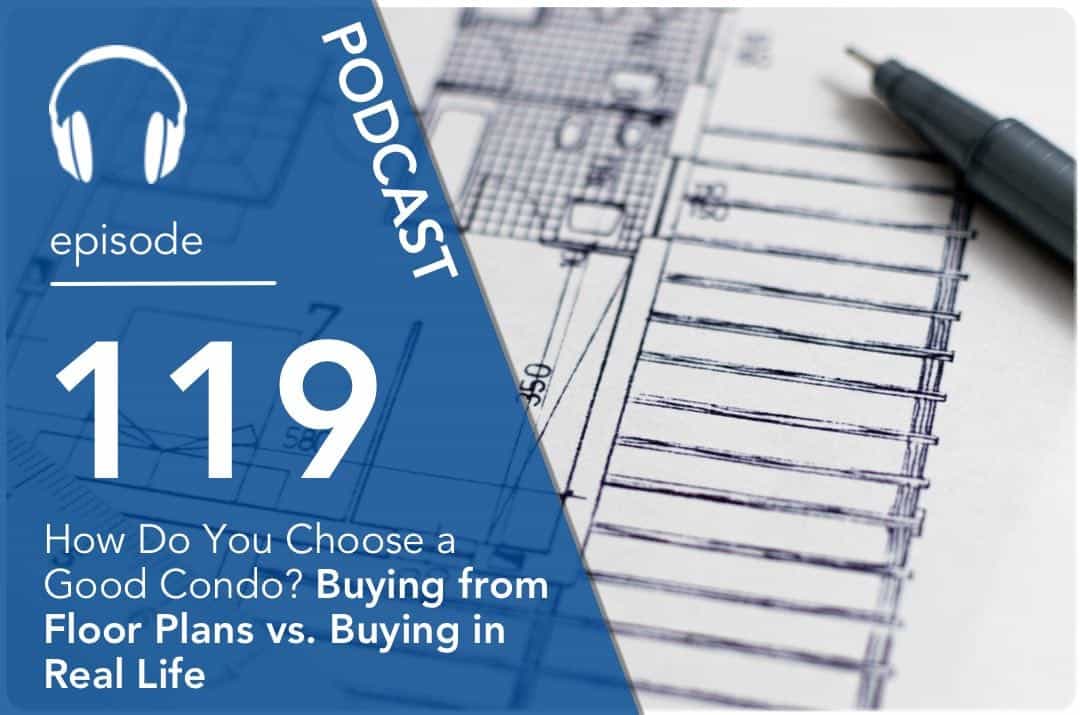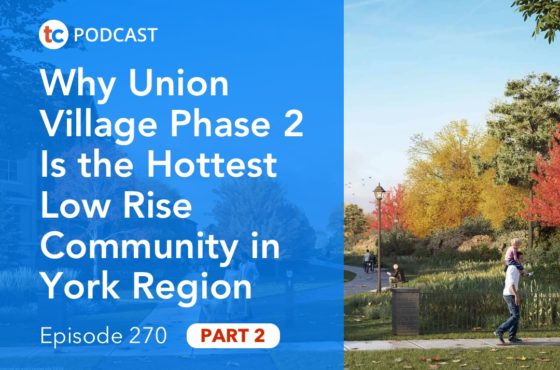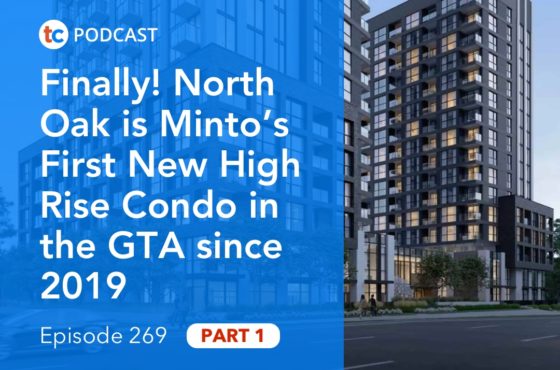How Do You Choose a Good Condo? Buying from Floor Plans vs. Buying in Real Life

How do you know what is a good unit to buy? People tend to buy from floor plans very differently than people do in real life – once the condo is built. Learn about some of the mistakes investors make when choosing a plan, and learn about what real life buyers and renters react to when stepping into a condo.
EPISODE HIGHLIGHTS
2:29 If we talk about buying from plans, what are people primarily reacting to?
4:12 You shouldn’t focus on price at the expense of everything else.
5:20 People are looking at layouts.
6:30 One of the big, big, big mistakes that people make.
10:00 How do people actually buy in real life.
13:35 Three reactions that people have when they’re going looking for a condo.
17:14 Another factor is what we call social proof.
Related Links
Click Here for Episode Transcript
Andrew la Fleur: How do you know what floor plan to buy? In today’s episode we’re going to talk about the differences between buying from floor plans and buying in real life, and how you can maximize your ROI as an investor. Stay tuned.
Speaker 2: Welcome to the True Condos Podcast with Andrew la Fleur, the place to get the truth on the Toronto condo market and condo investing in Toronto.
Andrew la Fleur: Hi and welcome to the show. We’re going to be tackling this question of what floor plan should you choose when you’re buying for investment, you’re buying a condo for investment. I think really the question that you should be asking yourself as an investor is, how do real people in real like buy or rent condos? How do they choose condos to purchase or to rent? Because so often we get stuck in the investor mentality of buying from floor plans when in real life people are actually walking into buildings and looking at properties physical, tangible properties, whereas we’re dealing with paper.
There are differences between how you buy or how people tend to buy from plans, and how people tend to buy in real life. I want to talk about some of those differences on today’s episode to help you ultimately get inside the mindset of your future buyer, your future renter, so that you can make the right decision on the unit that you’re picking. So often I’ve seen people the mistake of purchasing the wrong floor plan in pre-construction that nobody wants to buy or rent from them in the future. I shouldn’t say nobody but it’s less desirable of a unit in the future because they’re not taking certain things into consideration or they’re focusing too much on certain factors and not enough on the right thing that they should be focusing on. That’s what we’re going to be talking about in today’s episode.
The reality is that the way people react differently when you’re looking at floor plan versus looking in real life. There’s different reactions we’re going to be talking about as we answer this question. What are the reactions that people have and how that behavior should affect our decision making as investors? Let’s talk about from plans versus in real life. If we talk about buying from plans, what are people primarily reacting to? When you’re an investor you’re sitting there looking at what do I buy?
The number one thing absolutely that people are focusing on and reacting to when they think about choosing a unit is the price. Obviously people are at the end of the day price conscious and looking at how much does this condo cost. That’s the first thing that people are thinking, is, “How much money do I have to invest?” Therefor, “What units can I be able to purchase?” Obviously people tend to gravitate towards the cheapest unit in a given building. That’s the first mistake that people make, is constantly focusing too much on the cheapest unit.
The cheapest unit in the building, there’s usually a reason why they are the cheapest units. Sometimes the cheapest unit is the best investment or is a great investment, but sometimes, many times, there’s a reason why it is the cheapest unit. Maybe the view is staring into a wall 10 feet away, or maybe it’s right above the trash compactor where the garbage is taken out in the back alley, or maybe every unit in the building has a balcony but this one unit does not. There are so many factors. Maybe the ceiling heights are eight foot on this floor and the rest of the building is nine foot. There’s so many factors that could go into the pricing but that is where people tend to start.
It’s not necessarily a bad thing and it’s not something I’m saying you shouldn’t do, but I’m saying you shouldn’t focus on price at the expense of everything else. You need to understand the reason that go into price. People, when you’re buying from plans you tend to think about price, you tend to think the deposit structure of the given building versus other buildings and how much deposit you have to put down. You tend to look at what is the price of it relative to other competing offers in the marketplace. What is your budget, how much you can afford, what is your expected return on investment, et cetera. You’re thinking numbers, numbers, numbers, numbers. That’s the primary thing that you’re thinking about when you’re buying from plans.
The second thing that people tend to think about when buying from plans is looking at the lay out. “Show me the layout of the unit.” They’re thinking in general terms of, again you’re looking at paper, you’re not physically walking through an existing building, a completed building with 300 units for sale and you can just walk through every unit in the building and pick one. No, we’re buying from plans, we’re buying paper. When we’re buying that we’re looking at floor plans and people are looking at layouts.
They tend to think about things like, “Is the layout square? Is it weird shaped? Is there wasted space in the layout? The dimensions of the rooms, are they large rooms or small rooms? The kitchen, is it in a good spot or a bad spot?” These kind of things are what people are thinking about, but generally the main thing is thinking about, “Is it square? Is it rectangular? Are there any strange angles or anything in the unit? Does it look good on paper so to speak?” Those are sort of the two big things that people are looking at when they’re thinking of buying from plans. You’re probably thinking, “Yeah, makes sense Andrew, of course. What’s your point? Where are you going with this?” Bear with me, I’m getting there.
The secondary things people are sometimes looking at for buying from plans would be things like views. This is one of the big, big, big mistakes that people make, is getting way to focused on views and view exposures. Views in real life are really not that big of a factor. The big mistake that I find people make time and time again is everyone seems to be having this thing of looking for this perfect postcard unobstructed forever nothing can ever be build anywhere in front of my window view. Which is completely unrealistic and not something that should be expected, especially when you’re talking about downtown Toronto or anywhere urban for that matter, but especially downtown Toronto. The city is constantly growing and evolving and there’s constantly new buildings going up everywhere. Everyone’s view is always changing.
This notion that many people fall into of, “No, don’t want to buy that one because there’s potentially maybe a building coming up there 10 years from now or 15 years from now,” or, “I must see the see the CN Tower. If I cannot see the CN Tower then it’s a bad view,” or, “I have to be facing east, cannot be facing west,” or, “Must be facing north, cannot be facing south.” People are overly focused on views. Yes views are important but in real life we’ll talk about what is important in a moment, and views is really low down the list of what people are actually looking for in real life when it comes to choosing a condo to rent or to buy. Similarly another one is balconies. Everybody is obsessed with having a balcony on their unit when buying from plans.
Look around any condo building in Toronto, talk to anyone who lives in a condo building, they will agree that nobody uses their balconies. Maybe you use it five, eight, six times a year. Nobody’s using their balconies other than just for storing junk. Very few people are really using their balconies. Terrace is a bit of a different thing. Terrace is a unique feature that can certainly add a lot of value but balconies for whatever reason, it’s one of those things that everyone insists on having when you’re buying from plans but in real life very, very few people ever actually use, or if they do use it it’s a very rare thing that you’re going to spend any significant time on your balcony. It’s more of a nice to have feature when it comes to resell, but that is certainly a mentality that is hard for people to shake.
It’s something that for whatever reason, and especially in Toronto, if you’re in a warmer climate I understand but in Toronto with the winters that we have it’s something I’ve never really understood, is this obsession with having a balcony, must buy a unit with a balcony. You talk to anybody who lives in a condo, “Hey, you’ve got a balcony. Do you ever use it?” “No, never.” It’s just one of those things. That is how people tend to think about and buy from plans. Let’s talk about how do people actually buy in real life and understanding this is important for us as investors for how we’re picking our units.
Similar to when you’re buying from plans I think the number one thing still will always be price. In real life people always start with price, “What can I afford?” I’m looking to rent, I can afford 1,600 a month, or I can afford 1,800 a month, or $2,600 a month, whatever it is. That is your primary starting point. You’re looking, you’re starting there and you’re saying, “What is available at my price point?” You’re not looking at all price points, you’re looking at a very specific price point. That’s where you’re starting. Location is secondary really to price, you’re looking at price first. Obviously you are looking at location based on your needs and where do you want to live and where you need to live for family and friends and work and everything else. It’s all subject to price.
Next. Next is whereas investors tend to look at layouts and look at what is the layout? Is it square and so on? In real life people are not thinking about layout as much. They’re not saying, “Send me a floor plan, let me analyse the floor plan.” They’re saying, “What is the functionality of the unit? How does it function? What are the features of the unit? I have a certain price and I need certain features. I need a kitchen obviously, I need a bathroom. Maybe I need two bathrooms, maybe I need one bedroom or I need two bedrooms.” They’re looking at functionality.
This goes to something we talked about a lot in the podcast, is buying the smaller units of a given type that tends to be better for investment because people are buying up functionality so whereas an investor might say, “Look at this floor plan, it’s a nice spacious 600 square foot one bedroom.” You’re better off to buy the 500 square foot one bedroom because it’s much cheaper and at the end of the day they’re both one bedroom. The real life person is saying, “Is it a one bedroom? Yes or no?” They’re not saying, “How many square feet is it? Show me the layout.” Some are but most are just saying, “What’s the price? What’s the functionality?” In other words, “Is it a one bed? Is it a one plus den? Is it a two bed? Is it a three bed?” And so on. They’re looking at the functionality of the unit, how does it function day to day? If I’m a single, if I’m a couple, if I have kids, if I have a parent living with me, whatever it may be, that’s going to determine what functionality you need.
The square footage is not so much. People will adapt to the square footage, whether it’s smaller or bigger people will adapt, but the functionality they cannot adapt to that, it needs to have certain functionality, number of bedrooms, den yes or no, number of bathrooms, and that kind of thing, parking spot yes or no. Those are the key functional points of the unit and that’s how people are thinking about it. The next three things I want to talk about are three ways that people react, three reactions that people have or tend to have when they’re going looking for a condo. These are things that you cannot get necessarily or many people miss out when they’re looking at a floor plan.
The first is people react to light. People react to light, so the amount of light that is in the space. When you walk, when you physically walk into the unit, is there an ample amount of light? Again when you look at a floor plan it’s hard to get a sense of that, but when you walk into a physical space you can get a sense of it right away. Light of course, what drives light is the amount of glass, the amount of glazing and window space that a unit has that allows light to come in. Take a look at how much, that’s a quick tip, is just look at how much window space your unit has versus other units in the building.
If you can find a unit with more average window coverage than others then that could be a very positive thing when someone’s physically walking into that unit. It can give someone a very good feeling right away, whether it’s facing … If you get good floor to ceiling windows in a space it really doesn’t matter if it’s facing south, east, west. It can be facing north, you’re getting tons of light coming in if you’re getting that floor to ceiling, wall to wall glass, very important.
The next thing people tend to react to other than light, people tend to react to volume of space. Volume of space, a feeling of openness, a feeling of [volumous 00:15:20] space versus a feeling of being in a tight confined space. How does the unit feel? Is it spacious or not? That’s both inside the unit and out. Inside the unit, is there high ceilings? Is there an absence of bulkheads and things like that? Again it goes to the amount of light that’s coming in, but also outside, when you look out the window are you able to see far? Are you able to see horizon or is there a brick wall in front of you? Again that is making you feel like there’s less volume of space around you. An openness feeling, volume of space is one of the reactions that people have.
If there’s a lot of volume it’s a positive reaction, if there’s not enough volume it’s a negative reaction. The next thing is natural elements. People tend to react to natural elements. This can be achieved through design features in the unit but more so it’s what can you see from the window? Can you see trees? Can you some green? Can you see some grass? If you have some natural elements around you when you walk into the condo building, can you see green and grass? Those are the kinds of things that people will again react positively to. These are all things that you cannot necessarily pick up when you’re just looking at a floor plan on paper, but these are the kind of things you need to think about as you’re picking your plan.
Other factors from there, those are the key things I wanted to touch on but other factors would be what I call social proof or social acceptance. Is the building in an area that your target customer and their friends and family would want them to live? Is it known as a cool area, a good spot, or is it known as a sketchy area or a bad spot where people would not want to live or people would be ashamed of saying, “I live there,” or would people be proud to say they live there? That’s certainly a factor of how people think about real life, and again not necessarily something you can get off of a floor plan but something to consider.
Views, we talked about views, again being way overrated when you’re buying pre-construction. When someone’s in real life, my experience with working with real life buyers and renters, the view is way down the list after all these other things we talked about, light, volume of space, natural elements, the functionality of the space and obviously the price. The views are way down the list. Basically what I would say is as long as you’re not staring into a wall you’re okay.
As long as you are not literally staring into a wall 20 feet away from you you are okay. If there is a building across the street from you, you are okay. A building 60, 80, 100 feet away from you is not blocking your view. People fall into this trap when they’re buying pre-construction, they think, “There’s a building across the street, it’s blocking my view.” The building across the street is part of your view, it is not blocking your view. The only thing that’s blocking your view again is if there’s something that’s like 20 feet in front of you. 60, 80, 100 feet away, the way that your eyes work and take in your line of vision, it’s much broader than … We’re not tunnel visioned creatures, we can see 270 degrees or whatever it is field of vision. We can see much more than we think we can see when we’re trying to imagine ourselves in that unit when we’re buying from floor plans. That’s again another tip for buying pre-construction.
Finally again, balconies. Balconies again as I said are nice to have. We see units renting and selling all the time, all the time in resale without balconies and there are no issues there. Yes they’re going to sell for less than a unit that does have a balcony, but it should not be a deal breaker. Yes it’s nice to have, if you can get one you should, you might as well get one, but if you can get a unit that has great light, that has volume of space, that has some natural elements to it, that’s in a good building, a great location, has a good price, functionality is there, those things far outweigh if it has a balcony or not. Keep that in mind as well.
Okay, that comes to the end of our episode. I hope that you enjoyed today’s episode. I hope you got something from it. If you did why don’t you go ahead and share this episode with a friend or somebody you know who could benefit from it too. Until next time we will talk to you soon.
Speaker 2: Thanks for listening to the True Condos Podcast. Remember your positive reviews make a big difference to the show. To learn more about condo investing, become a True Condo subscriber by visiting truecondos.com.






